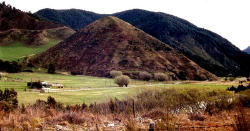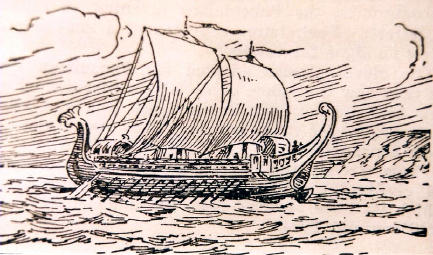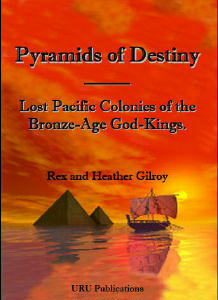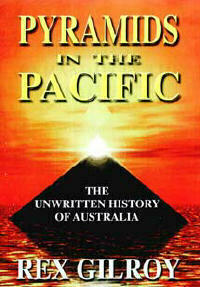
| Pyramids of Destiny – Lost Pacific Colonies of the Bronze-Age God-Kings |
 |
A Phoenician merchant ship of Roman times. One of a number of large, ocean-going vessels in which these adventurous mariners sailed Australasian waters and beyond.
Sketch copyright ©
|
Pyramids of Destiny – Lost Pacific Colonies of the Bronze-Age God-Kings
by Rex & Heather Gilroy
Copyright
© Rex Gilroy 2009
| “Australian history is almost always picturesque; indeed it is so curious and strange, that it is itself the chiefest novelty the country has to offer, and so it pushes all other novelties into second and third place. It does not read like history but like the most beautiful lies. Mark Twain: Following the Equator [1891] |
”Every truth passes through three stages before it is recognised. In the first, it is ridiculed. In the second, it is opposed. In the third, it is regarded as self evident.” Arthur Schopenhauer [1788-1860] |
Part Two.
Old World Voyages to Australantis.
Chapter Nine.
Egyptian Voyages to the Land of Set.
The historical information in this chapter comes from the authors book “Pyramids in the Pacific – The Unwritten History of Australia [URU Publications 2000] and other published material listed in the bibliography.“The mines in the mountains are watched over by Ra’s Eye,
the Sun, as he rises over the ocean to shine even in winter.
He cares for the land with his light.
Tana, our king, the dark-haired, arrived here by the
“Ship of the Royal Banner”.
He officiates at the pyramid and rules over the
mines of shining gold and copper”.Inscription found on the “Lost Pyramid of Far North
Queensland” by Rex and Heather Gilroy.While European explorers from the beginning of the late 15th century onwards could thank the Arab scientists and astronomers of earlier times for their knowledge, the Arabs themselves owed much of their expertise to the writings of earlier maritime civilisations, whose writings would have been lost forever were they not copied down and preserved in their libraries.
Knowledge passed down from ancient Sumerian, Indo-Aryan, Phoenician and Egyptian mariners, map-makers, geographers and chroniclers who regarded the world’s oceans as mighty watery highways over which their ships sailed, long centuries before the Age of Columbus, Magellan and Cook.
In laying the foundations of our thesis on the discovery, exploration and establishment of mining colonies in the Australian region from Bronze-Age times onwards, Heather and I have so far presented what we believe to be a strong case, not only for the origin of the earliest modern humans in Australia, but for the rise of the first civilisation of humankind on this continent in the form of the Uru.
This civilisation was to influence the rise of the later Old and New World cultures, who in turn would preserve traditions of an earlier golden age when their ancestors lived on a now long-lost paradise land, the “Motherland’ of all humankind, situated in the southernmost region of the world. In putting to sea to rediscover this land of origin of their forefathers, they would come a full circle as it were in the reclaiming of the land of their ancestors. Among these people were the Egyptians.
It is not our intention to present a lengthy history of the Egyptian civilisation as the reader can find this in any number of books on the subject. Instead we shall focus upon those aspects of Egypt’s history pertinent to their presence in Australasian waters; for while conservative Egyptologists speak of the might of the Egyptian civilisation their attention is firmly fixed upon the land of the Nile, whereas from what is to be presented in forthcoming chapters of this book, it will become evident that Egypt’s ‘unknown’ Australasian colonises covered a territory far greater in size that that of the homeland itself.This book will show that the Egyptians and their allies were present in Australia at the beginning of the old Kingdom [2780-2100 BC], establishing mining colonies inhabited by vast numbers of people who had to have been transported here in huge wooden ships in fleets composed of massive numbers of vessels.
As early as 3000 BC Egyptian vessels ventured down the African east coast to Somaliland, which they named Punt’, and about 2400 BC they sailed down the west coast to reach this country by rounding the ‘Horn’, where they found gold,. The name ‘Punt’ would also be used to describe the mysterious southern continent, also to be named by them as Kenti-Amenti, the fabled “Land of the Gods”.
By 2000 BC, Egyptian traders had established contact with the Phoenicians, to become what would be a fortuitous relationship. Phoenician ship-builders and mariners taught the Egyptians better ship-building and navigation skills, and were soon employed to steer Egyptian vessels on lengthy voyages of trade and mineral-seeking.
The Phoenicians, who have been called the “Vikings of the Biblical Age”, conquered the world’s oceans in their search for riches. They occupied a narrow strip of Syrian coastline bordered on the west by the Mediterranean Sea, and on the east by the mountains of Lebanon. Here they became renowned for their manufacture of a purple dye from sea snails, an industry that brought them great profits and gave the country its name – Phoenicia – “meaning “land of purple”.
The Phoenicians became famous throughout the Mediterranean for their seamanship, their crafts [particularly glass making], and their expertise in locating mineral deposits by examining the minute grains of rock, quartz and other tiny fragments scattered about ants nests. By this means they developed the uncanny ability to locate gold reefs and deposits of tin, copper and other precious metals and gemstones!
Pomponius Mela, the Spaniard, wrote of them in the 1st century AD:
“The Phoenicians were a clever race, who prospered in war and peace.
They excelled in writing and literature, and in other arts, in
seamanship, in naval warfare, and in ruling an empire”.The Roman chronicler, Strabo [64-20 AD] described them as “the white Syrians” and that they were tall in stature, wearing the conical ‘Phrygian’ cap, snow boots with turned up toes and garbed in Gothic-style dress.
While the eastern Mediterranean Phoenicians carried their trade into the Indian Ocean and beyond, the western Mediterranean Phoenicians of Carthage and Iberia [Spain] explored the Atlantic Ocean, down the West African coast and northwards to the British Isles and elsewhere in search of gold, copper and tin, which they discovered and mined in Cornwall and also in Brittany. Their successes would be the envy of Greece and Rome.
Main Book Index | Mysterious Australia Homepage | URU Homepage | Australian Yowie Research Centre

